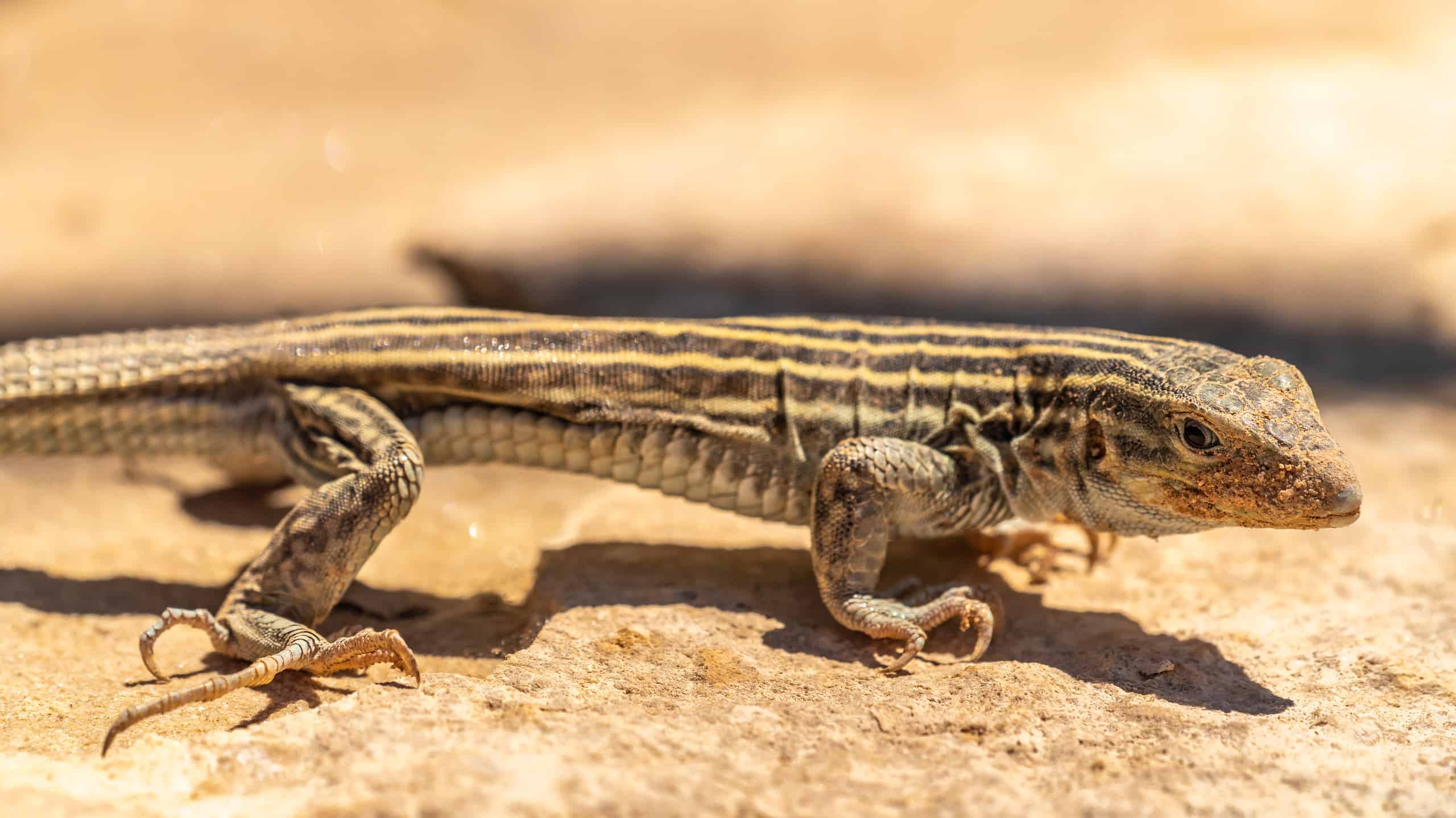From the rugged mountains of the Sangre de Cristo range to its arid southern deserts, New Mexico is a state of breathtaking landscapes, deep roots, and unique cultural traditions. This state is home to a number of national parks and monuments, including Carlsbad Caverns, White Sands, and Bandelier National Monument. The official state animals of New Mexico embody its natural splendor and rich cultural heritage. Let’s take a closer look at these impressive animals!
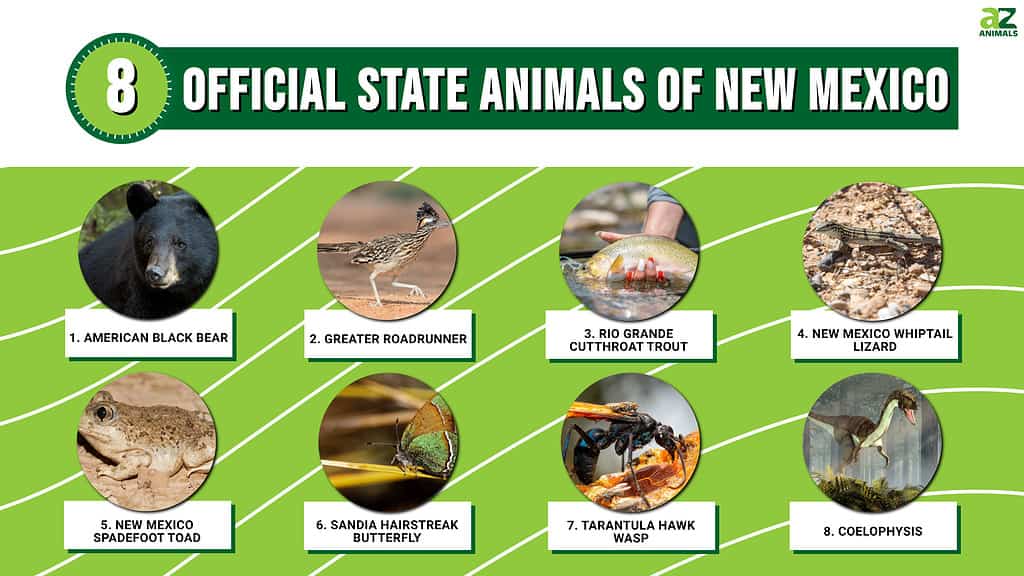
Among New Mexico’s designated state animals are an Amphibian, Butterfly, and Fossil.
©
1. State Mammal: American Black Bear (Ursus americanus)
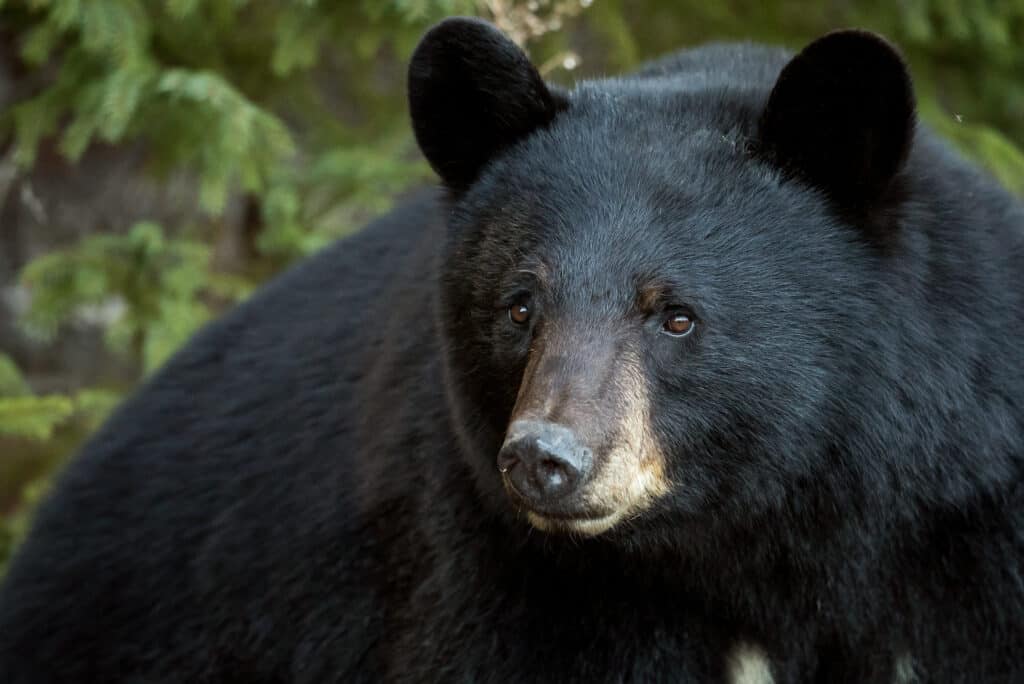
The American black bear became the official state mammal of New Mexico on February 8, 1963.
©iStock.com/Brittany Crossman
Did you know that one of the most famous black bears in the entire world was actually born in New Mexico? Smokey the Bear, the famous icon of fire prevention in the United States, was actually a real bear who was born in Capitan, New Mexico. Rescuers found him in 1950 when he was just three months old, trying to escape a massive forest fire in the Lincoln National Forest. Smokey spent much of his life as a living mascot for the U.S. Forest Service, and after his death, he was buried in New Mexico’s Smokey Bear Historical Park.
The American black bear became the official state mammal of New Mexico on February 8, 1963. Black bears are very intelligent animals that can weigh several hundred pounds. However, it is pretty rare to see an American black bear in New Mexico — even though there are many in the state — because they are secretive and rather shy. American black bears live in high elevations up in the mountains, often in areas with wooded forests and grass meadows. They are omnivores who eat many types of plants as well as insects, small rodents, and sometimes carrion. In New Mexico, American black bears are protected game animals, and you can only hunt them with a license in specific areas and on certain years.
2. State Bird: Greater Roadrunner (Geococcyx californianus)
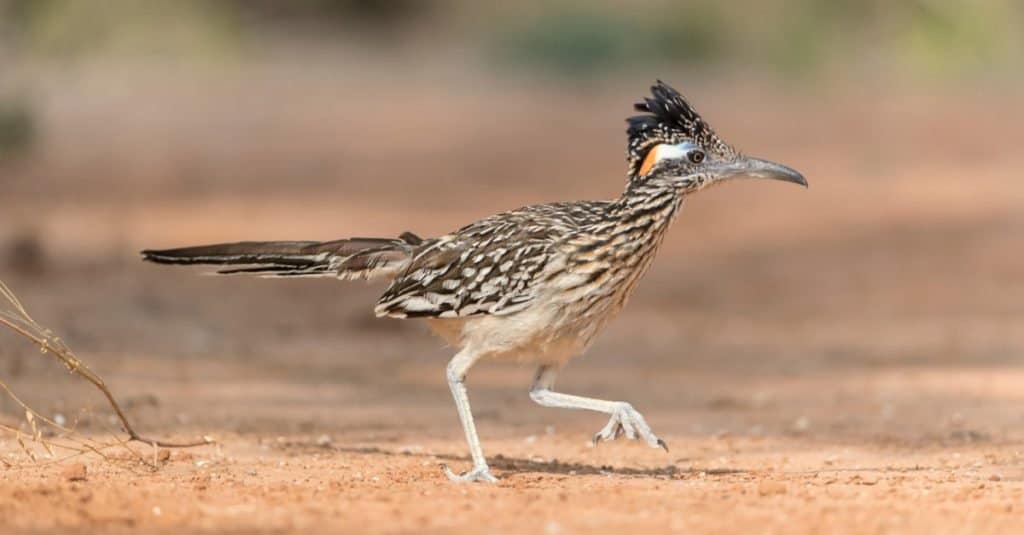
New Mexico’s state bird is the greater roadrunner.
©Dennis W Donohue/Shutterstock.com
The greater roadrunner became the official state bird of New Mexico on March 16, 1949. It is a type of ground cuckoo that lives throughout much of the state, usually in lower elevations under 7,000 feet. Unlike the American black bear, however, greater roadrunners are a common sight in New Mexico. You can frequently spot them running alongside trails and roads throughout the state. These ground birds can run 15 to 25 miles per hour, and they eat small reptiles, rodents, insects, scorpions, and tarantulas. They actually fly but they are not very good at it, so they prefer to run on the ground.
Greater roadrunners are pretty large birds that measure 20 to 24 inches long, have wingspans up to 24 inches, and stand about 10 to 12 inches tall. They have brown upper bodies with black streaks and sometimes pink spots. Their necks and the upper part of their breasts are usually white or light brown with darker brown streaks, while their bellies are white. Their most distinctive features are their long tails and the super cool crest of brown feathers on top of their heads.
The people of New Mexico have a strong connection and cultural history with the greater roadrunner. Early settlers were often told that a roadrunner could help them find their way if lost. Many Native Americans also honored the spirit of the roadrunner and used it as a symbol to ward off evil spirits. These unique ground Birds have X-shaped footprints that can make it hard to tell which direction the bird was running in. Because of this, Hopi tribes often used an X-shaped symbol to represent the birds’ footprint to confuse bad spirits.
3. State Fish: Rio Grande Cutthroat Trout (Oncorhynchus clarkii virginalis)

New Mexico’s state fish is the Rio Grande cutthroat trout, which has distinctive black spots.
©iStock.com/Wirestock
In 1955, the Rio Grande cutthroat trout became the official state fish of New Mexico. Also known as the New Mexico cutthroat trout, this fish can be found in many of the cold mountain lakes and streams in the northern parts of the state. Rio Grande cutthroat trout have brown, gray, green, or yellow bodies scattered with lots of bold black spots. These spots become more numerous toward the end of the fish, especially on its tail. They are usually around 10 inches long and get their name from the red streaks under the fish’s throats.
Rio Grande cutthroat trout need cold flowing water that is clean and clear in order to survive. They eat many different types of aquatic invertebrates, such as zooplankton, insects, and crustaceans. Unfortunately, in recent years the populations of these fish have declined in New Mexico due to human activities and the introduction of rainbow trout to their habitats. However, the New Mexico Department of Game and Fish has instituted a program that will hopefully restore the numbers of Rio Grande cutthroat trout in the state.
4. State Reptile: New Mexico Whiptail Lizard (Cnemidophorus neomexianus)

All New Mexico whiptail lizards are female, with the ability to produce eggs that do not require any fertilization.
©Elliotte Rusty Harold/Shutterstock.com
The New Mexico whiptail lizard is a very unique animal that became the official state reptile in 2003. One of the things that makes this lizard so special is that all new Mexican whiptails are female! Yep, there are no male New Mexico whiptails! That is because this quick little lizard is a parthenogenetic hybrid. This means that there are two ways to produce a New Mexico whiptail. First, some are hybrids born from one western whiptail parent (Aspidoscelis tigris) and one little striped whiptail parent (Aspidoscelis inornatus). When these two different species breed, the genetics that form in their offspring make it so that only females will develop.
Believe it or not, the only other way to produce a New Mexico whiptail is through a unique form of self-cloning! That’s right, these small little desert lizards have figured out how to produce their own clones! The eggs of a New Mexico whiptail do not require any fertilization and the babies that hatch from them can receive all of the mother’s genes or just part of them.
Like their name, New Mexico whiptails have long tails like a whip, with dark gray, black, or brown bodies patterned with light yellow stripes and spots. They grow around 6.5 to 9 inches long and can run up to 15 miles per hour! When they run, they sometimes stand upright on their little hind legs, making them look like speedy little dinosaurs! New Mexico whiptail lizards typically live in central and southwest New Mexico. They prefer desert grassland areas, shrublands, disturbed riverside habitats, rocky areas, and mountainside woodlands.
5. State Amphibian: New Mexico Spadefoot Toad (Spea multiplicata)
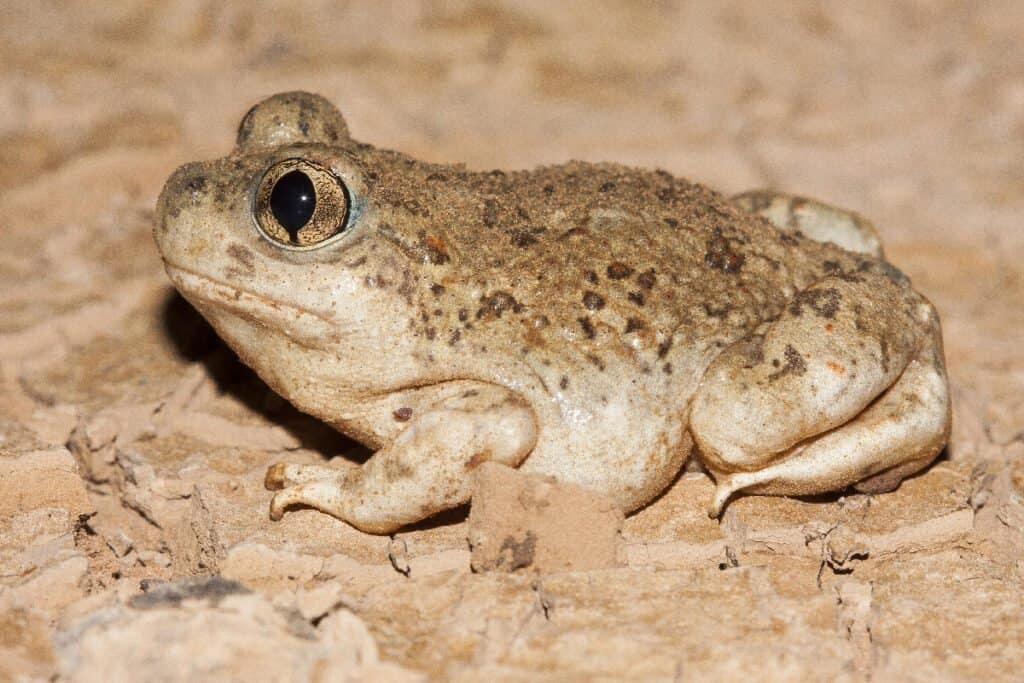
New Mexico spadefoot toads are often brown, gray, or dusky green.
©Viktor Loki/Shutterstock.com
Found in nearly every county of the state, the New Mexico spadefoot toad became the official state amphibian in 2003. These small toads are usually just 1.5 to 2.5 inches long. Their cute little round bodies come in various colors that usually match the soil where they live. New Mexico spadefoot toads are often brown, gray, or dusky green, and sometimes have tiny orange and black speckles on their backs. Their bellies are white, and they have very large eyes with vertical pupils on top of their heads.
New Mexico spadefoot toads are secretive animals that usually only come out at night. If they are threatened or handled, these little toads will emit a unique odor that smells kind of like roasted peanuts. They dig burrows into moist soil, and usually only come out during summer rains. The male toads emerge from their underground burrows first and use their unique vocalizations to call for females. Their calls are very distinct, and many say they sound like someone running a fingernail across the teeth of a comb.
6. State Butterfly: Sandia Hairstreak Butterfly (Callophrys mcfarlandi)
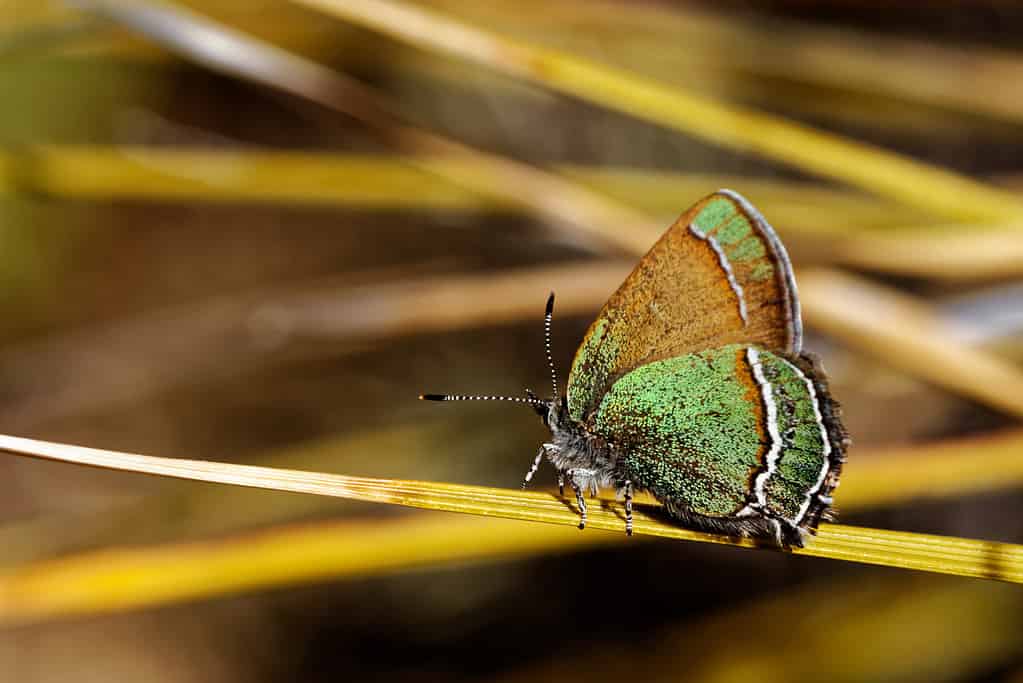
New Mexico’s state butterfly, the Sandia hairstreak, lives across 24 counties in the state.
©D. Longenbaugh/Shutterstock.com
The Sandia hairstreak butterfly was chosen as the official state butterfly of New Mexico in 2003. These delicate little butterflies live in at least 24 counties in New Mexico, typically in dry hillside habitats. Depending on the year, sometimes Sandia hairstreak butterflies are the most numerous butterflies in the area. They were first discovered in Albuquerque, New Mexico, in 1960.
Sandia hairstreak butterflies are active insects that are well-adapted to dry conditions. Their wingspan measures between 1 and 1.25 inches, and the underside of their wings is a beautiful golden green with an iridescent shimmer. Female butterflies showcase striking reddish brown wings on the top side, while the males’ wings are more of an earthy shade of brown. Both have delicate black and white border stripes. Sandia hairstreak larvae (caterpillars) can be many different colors including green, maroon, and pink.
7. State Insect: Tarantula Hawk Wasp (Pepsis formosa)
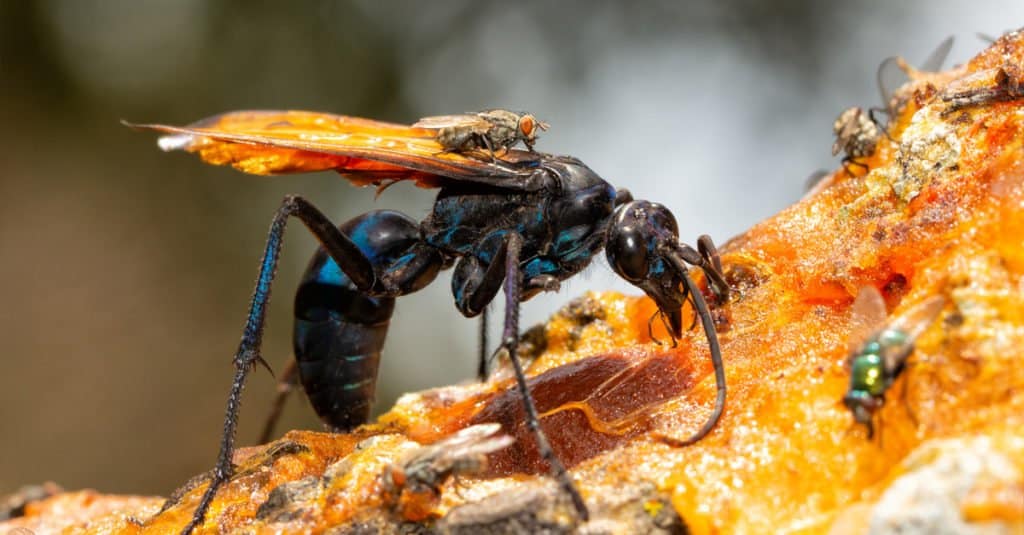
Tarantula hawk wasps are one the largest species of wasps in the U.S., and known to have one of the most painful stings.
©Sari ONeal/Shutterstock.com
This creepy-crawly creature became the official state insect of New Mexico in 1989. The tarantula hawk wasp is one of the largest species of wasps found in the United States, measuring up to 2 inches long. These massive wasps have a very distinctive appearance with jet-black bodies, bold orange wings, and long legs. They live in burrows that often have branching tunnels.
Like their name, Tarantula hawk wasps hunt tarantulas. They are also “parasitoid” wasps, which means that they lay their eggs on other living creatures! Using their venomous stings to paralyze tarantulas, the wasps then drag them back to their underground nests. Female tarantula hawks then lay a single egg on the paralyzed tarantula, which will become dinner for her newly hatched larva!
There are very few predators that hunt and eat tarantula hawk wasps, as they have one of the most painful insect stings on earth. However, the state bird of New Mexico, the greater roadrunner, is one of the few animals that can eat these massive insects.
8. State Fossil: Coelophysis

New Mexico’s official state fossil belongs to the
Coelophysisdinosaur that lived during the Triassic Period.
©Daniel Eskridge/Shutterstock.com
Coelophysis became the official state fossil of New Mexico on March 17, 1981. The very first fossils of this dinosaur actually came from New Mexico back in 1881! Coelophysis was a carnivorous dinosaur that lived during the early Triassic Period. However, it was not nearly as large as the meat-eating dinosaurs that you often see in movies. Instead, Coelophysis grew only about 9 feet long, 3 feet high at its hips, and only weighed around 50 pounds. Its name comes from a Greek term that means “hollow form”, which refers to the dinosaur’s hollow limb bones.
Coelophysis had a very long tail, which was probably used to help balance it as it ran at high speeds on its hind legs. It also had sharp, serrated teeth like many carnivorous dinosaurs. These continually replaced themselves whenever the old ones wore out. It was likely that Coelophysis was an opportunistic feeder that ate both live prey and scavenged dead animals. Some scientists even speculate that Coelophysis may have also been warm-blooded!
Bonus: Dusty Roadrunner, New Mexico’s State Clean-Up Mascot
In addition to being the state bird, New Mexico also adopted a roadrunner as its state mascot: Dusty Roadrunner. Created in 1964, Dusty is an official state symbol that helps educate residents on how to keep New Mexico clean and beautiful. Dusty is often seen hard at work with a red cap and a broom.
Summary of 8 Official State Animals of New Mexico
Here’s a recap of New Mexico’s eight official state animals.
| Number | State Designation | Animal | Scientific Name | Year It Was Designated |
|---|---|---|---|---|
| 1 | State Mammal | American Black Bear | Ursus americanus | 1963 |
| 2 | State Bird | Greater Roadrunner | Geococcyx californianus | 1949 |
| 3 | State Fish | Rio Grande Cutthroat Trout | Oncorhynchus clarkii virginalis | 1955 |
| 4 | State Reptile | New Mexico Whiptail Lizard | Cnemidophorus neomexianus | 2003 |
| 5 | State Amphibian | New Mexico Spadefoot Toad | Spea multiplicata | 2003 |
| 6 | State Butterfly | Sandia Hairstreak Butterfly | Callophrys mcfarlandi | 2003 |
| 7 | State Insect | Tarantula Hawk Wasp | Pepsis formosa | 1989 |
| 8 | State Fossil | Coelophysis | Coelophysis | 1981 |
Thank you for reading! Have some feedback for us? Contact the AZ Animals editorial team.

